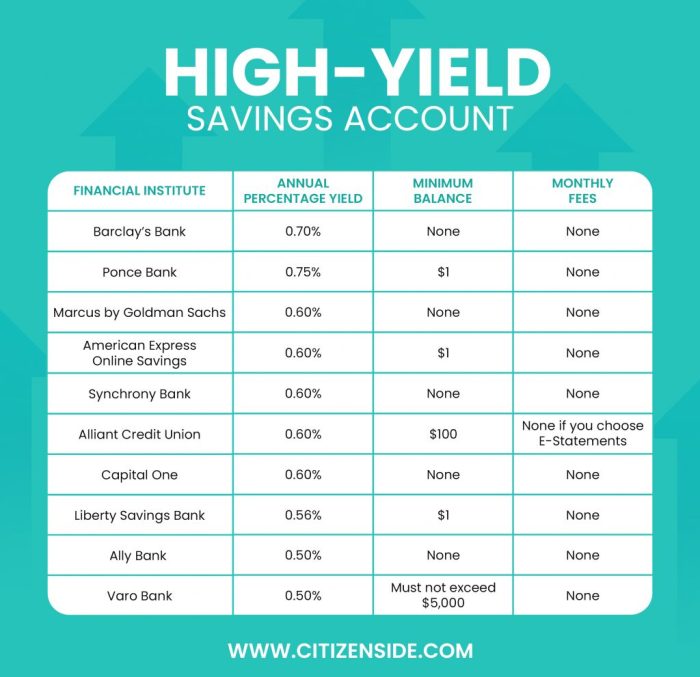Diving into the world of high-yield savings accounts, we’re about to embark on a journey that will change the way you view saving money. Get ready to explore the ins and outs of these accounts in a way that’s both informative and exciting.
In the following paragraphs, we’ll break down what high-yield savings accounts are and how they can benefit you in ways you never imagined.
Understanding High-Yield Savings Accounts

In today’s financial landscape, high-yield savings accounts have become a popular option for individuals looking to maximize their savings. These accounts offer higher interest rates compared to traditional savings accounts, providing an opportunity for account holders to grow their money more efficiently over time.
What is a High-Yield Savings Account?
A high-yield savings account is a type of savings account that offers a higher interest rate than a standard savings account. These accounts are typically offered by online banks or credit unions and provide a competitive APY (Annual Percentage Yield) on deposited funds.
- High-yield savings accounts are known for their attractive interest rates, which can be several times higher than those offered by traditional brick-and-mortar banks.
- These accounts are FDIC-insured, just like regular savings accounts, providing a safe and secure way to save money while earning a higher return.
- Unlike traditional savings accounts, high-yield savings accounts often come with no monthly maintenance fees or minimum balance requirements, making them accessible to a wide range of savers.
Benefits of High-Yield Savings Accounts
When compared to regular savings accounts, high-yield savings accounts offer several advantages that can help account holders reach their financial goals faster.
- Higher Interest Rates: The main draw of high-yield savings accounts is the significantly higher interest rates they offer, allowing savers to earn more on their deposits over time.
- Compounded Growth: With the power of compounding, the interest earned on a high-yield savings account is added to the principal balance, leading to accelerated growth of savings.
- Liquidity and Accessibility: High-yield savings accounts provide easy access to funds for emergencies or planned expenses, without sacrificing the competitive interest rates they offer.
Choosing the Right High-Yield Savings Account
When selecting a high-yield savings account, there are several factors to consider to ensure you are getting the best option for your financial goals. It’s essential to compare interest rates, understand any associated fees, and identify ways to minimize them.
Interest Rates
- Compare interest rates offered by different financial institutions to find the highest yield for your savings.
- Look for accounts with competitive rates that will help your money grow faster over time.
- Consider whether the interest rate is fixed or variable, as this can impact your earnings.
Fees
- Be aware of any maintenance fees, minimum balance requirements, or transaction fees associated with the account.
- Look for accounts with no or low fees to maximize your savings.
- Consider setting up direct deposit or maintaining a minimum balance to avoid fees.
Depositing and Withdrawing Funds
When it comes to managing your high-yield savings account, understanding how to deposit and withdraw funds is crucial. Let’s dive into the details.
Depositing Money
- Direct Deposit: You can set up direct deposit from your paycheck or other income sources directly into your high-yield savings account.
- Bank Transfers: Transfer money from your linked checking account to your high-yield savings account online or through mobile banking.
- Mobile Check Deposit: Some banks allow you to deposit checks into your high-yield savings account by simply taking a picture of the check with your mobile device.
Withdrawing Funds
- ATM Withdrawals: Some high-yield savings accounts offer ATM cards that allow you to withdraw cash from ATMs.
- Electronic Transfers: You can transfer money from your high-yield savings account to another linked account electronically.
- Bank Branch Withdrawals: Visit a physical bank branch to withdraw funds in person.
Limitations and Restrictions
- Minimum Balance Requirements: Some high-yield savings accounts have minimum balance requirements that must be maintained to avoid fees or restrictions on withdrawals.
- Monthly Transaction Limits: There may be limits on the number of withdrawals or transfers you can make from your high-yield savings account each month.
- Withdrawal Fees: Be aware of any fees associated with withdrawing funds from your high-yield savings account, especially if you exceed the allowed number of transactions.
Maximizing Returns
When it comes to high-yield savings accounts, maximizing returns is crucial for growing your savings efficiently. By following smart strategies and consistently contributing to your account, you can take full advantage of the benefits offered.
Regular Contributions
Regularly contributing to your high-yield savings account is key to increasing your savings over time. Set up automatic transfers from your checking account to ensure you’re consistently adding to your savings without having to think about it.
- Establish a budget: Create a budget that includes a specific amount to be transferred to your high-yield savings account each month.
- Take advantage of windfalls: Whenever you receive unexpected money, such as a bonus or tax refund, consider putting a portion of it into your savings account.
- Increase contributions over time: As your financial situation improves, try to increase the amount you contribute to your savings account to accelerate your savings growth.
Compound Interest
Compound interest plays a significant role in growing your savings within a high-yield savings account. This powerful force allows your money to earn interest on both the initial deposit and the accumulated interest, leading to exponential growth over time.
Compound interest is the interest calculated on the initial principal and also on the accumulated interest of previous periods.
To maximize the benefits of compound interest, it’s essential to leave your savings untouched and allow them to grow over the long term. The more time your money has to compound, the larger your returns will be.
